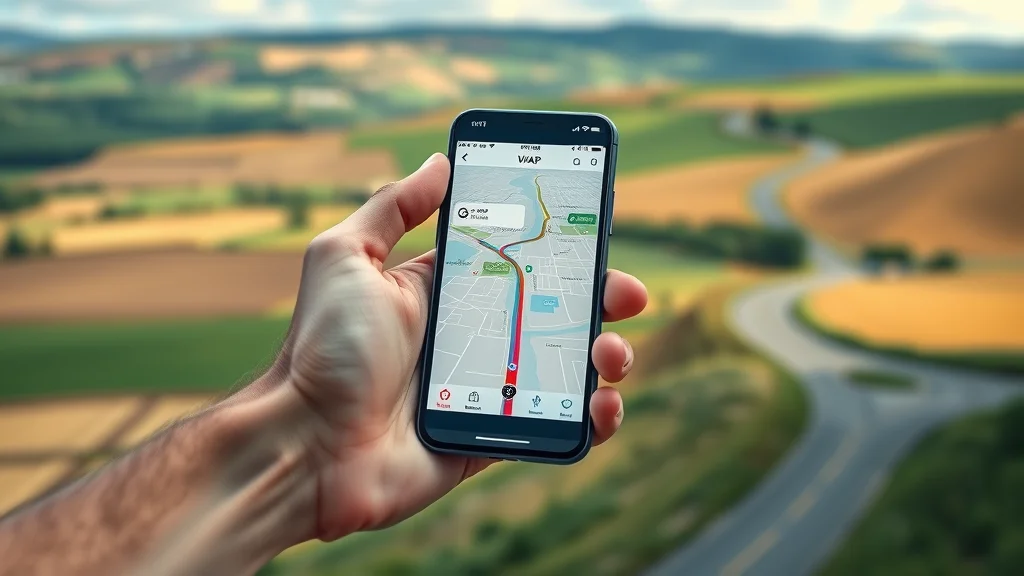Did you know that over 70% of travelers lose mobile connectivity at least once during international trips? An offline maps app is no longer a luxury—it’s a necessity for safe, seamless navigation.
Imagine you’re exploring a vibrant foreign city or trekking along a remote hiking trail, only for your internet connection to vanish. Suddenly, you’re disoriented, unable to find your hotel or the nearest public transit stop. The truth is, unexpected connectivity issues can turn a dream trip into a stressful ordeal. That’s where an offline maps app becomes your must-have travel companion, ensuring you never get lost, regardless of where life takes you. This article reveals why downloading one should top your travel checklist, how leading apps compare, and which features matter most for every kind of journey.
- What You’ll Learn
- The key benefits of using an offline maps app when traveling
- Comparison between organic maps, Google Maps, and other offline map options
- Practical use cases for offline maps apps
- Steps to download and use offline maps on iPhone and Android

Offline Maps App: The Game-Changer for Global Travelers
The demands of modern travel have shifted—today, relying solely on online navigation tools can leave you stranded when it matters most. Whether you’re hopping between cities, embarking on a road trip, or tackling iconic hiking trails, mobile network dead zones are common. International roaming fees or lack of local SIM cards add further complications. With an offline maps app installed on your mobile device, all these issues fade away. These tools provide detailed maps, public transit options, walking directions, and up-to-date road events—even without an internet connection or international plan. Gone are the days of fumbling with a paper map or panicking if you wander off your planned route. The right offline map puts accurate, real-time navigation always within reach, unlocking new destinations and giving you the freedom to explore with confidence. As more travelers recognize the importance of privacy practices and data security while abroad, privacy-first offline maps like organic maps offer peace of mind, helping you protect your movements from being linked to your identity.
"Did you know that over 70% of travelers lose mobile connectivity at least once during international trips? An offline maps app is no longer a luxury—it’s a necessity for safe, seamless navigation."
What Is an Offline Maps App?
Defining Offline Maps and Their Advantages
An offline maps app is a navigation tool that allows users to access, search, and interact with detailed maps without needing an active internet connection. By downloading map data directly to your mobile device or SD card, you can get accurate guidance for driving, walking, hiking, or public transport even in areas without Wi-Fi or mobile service. Notable choices in this space include organic maps, Google Maps, and specialized offline apps designed for outdoor adventures. Unlike online-only solutions, offline maps are available the moment you open the app, saving you from slow loading screens, bug fixes, or the dreaded “no signal” alert when you’re far from urban centers. Offline map options also frequently include added track features for hiking trails, making them invaluable for outdoor enthusiasts. For long-term travelers or those on a road trip, relying on an offline map ensures you’re prepared for both expected and unexpected detours, all without the need for continual data downloads.
- offline maps
- offline map
- organic maps
- google maps
How Offline Maps Apps Differ From Traditional Mapping Tools
Unlike traditional mapping apps that require a stable internet connection, offline maps apps are engineered for reliability in the most challenging settings. They not only let you download maps ahead of time for entire regions or countries but are built to minimize battery consumption—crucial for long days of exploring where a power outlet may not be nearby. This makes offline map apps a favorite among backpackers, solo travelers, and international explorers aiming to avoid expensive international plans. In emergencies, such as getting lost on a hiking trail or experiencing a phone signal outage in a foreign city, offline maps serve as an essential safety net. Their robust search function, reliable current location tracking, and route color customization features—like unique arrow color and added track filtering—add to the user experience. Whether you’re searching for hotels, public transport options, or the next scenic overlook, these apps empower you to go further, worry-free, and with total independence from the grid.
- Reliability
- No need for internet
- Lower battery consumption
- Emergency use

Top Features to Look For in an Offline Maps App
When choosing the right offline maps app for your adventures, it’s important to consider the features that will best serve your needs. Detailed offline map coverage is crucial—ensure the app provides comprehensive data for your destination, from city centers to remote hiking trails and winding back roads. Many top apps offer layers for hiking trails, cycle routes, and even public transport, making them practical beyond standard navigation. Integration with travel guides or the ability to highlight road events and scenic spots can enhance your trip, letting you discover more with less guesswork. A quality offline map app should support both iPhone and Android devices, offer easy map region downloads, and present an intuitive interface for quick searching and on-the-go changes. Privacy-conscious travelers should prioritize apps like organic maps with openstreetmap data and transparent privacy practices. Comparing organic maps and Google Maps can reveal differences in hiking coverage, privacy, platform compatibility, and price—a vital consideration for informed decision-making.
- Detailed offline map coverage
- Integration of hiking trails and travel guides
- Comparison: organic maps vs google maps vs standard offline map apps
- Device compatibility (iPhone, Android)
Best Offline Maps App Options for 2024
Organic Maps: Privacy-First Offline Maps App
"Organic Maps stands out for its open-source, no tracking policy, and accurate hiking trails."
For travelers who prioritize privacy and open data, Organic Maps is a leading offline map choice. Free, open-source, and absolutely no tracking, it uses OpenStreetMap data—meaning your navigation is never linked to your identity. Organic Maps is renowned for its up-to-date hiking trails, public transport options, and minimalistic yet powerful interface. The app’s bug fix process is transparent, and community contributions keep map details and road events current. Its ability to store data on your phone or SD card, efficient battery use, and frequent bug fixes make it especially appealing to digital nomads and privacy-minded explorers who want to avoid their travel data being collected by third parties.
Google Maps: How to Use Google Maps as an Offline Maps App
Even if you already use the Google Maps app, you might not realize its powerful offline capabilities. By searching for your destination, selecting “Download offline map,” and saving the area directly on your device, you can enjoy most of Google’s navigation features—including current location, route color choices, and live public transit data—even without an internet connection. The Google Maps app is a versatile option for travelers who want a familiar interface and robust search function. However, users should be aware of the privacy practices associated with Google, which may include sharing some location or usage data. With regular bug fixes, continual improvement, and easy access on both iOS and Android, Google Maps remains a competitive offline map solution, especially for those who already rely on its online version.
Comparing Popular Offline Maps Apps: Table Overview
| Offline Maps App Name | Map Coverage | Hiking Trails | Platform Support | Privacy | Price |
|---|---|---|---|---|---|
| Organic Maps | Worldwide, detailed | Extensive | iPhone, Android | Open-source, no tracking | Free |
| Google Maps | Worldwide, broad | Limited | iPhone, Android | Linked to your identity | Free |
| MAPS.ME | Global, medium detail | Good | iPhone, Android | May track some data | Free/Paid |
| Sygic | World, car-focused | Limited | iPhone, Android | Partial tracking | Paid |
How to Use an Offline Maps App Effectively
Using your offline maps app to its full potential can be the difference between a stress-free adventure and a logistical headache. The first step is to download maps for your intended destinations while you still have access to fast Wi-Fi. This allows you to avoid last-minute surprises and ensures a detailed map is always at your fingertips. Learn how to enable search function features, access route guidance, and save custom locations—like hotels, attractions, or trailheads. For best performance, keep your app updated so you benefit from the latest bug fixes and added track information. Many offline maps apps also offer options to personalize arrow color and route color, optimizing navigation to your preferences. Always test your chosen offline maps app before departure: check for map detail, try a route offline, and configure SD card storage if available. These steps will guarantee a reliable navigation experience whether you’re traveling internationally or exploring remote hiking trails.
- Step-by-step: downloading maps offline for travel
- Tips for using offline maps apps without internet
- Maximizing accuracy and updates
- Using offline maps for hiking trails
Offline Maps App Use Cases: From Urban Areas to Hiking Trails
Offline maps apps aren’t just for emergencies—they’re designed for every scenario, from navigating bustling city streets to finding your way along forested paths. In big cities, these apps help you manage public transit changes, avoid traffic, and locate amenities, including hotels and attractions, without searching for Wi-Fi. For outdoor lovers, a high-quality offline map gives accurate directions and added track filtering for hiking, ensuring you reach every trail marker safely—even in areas with zero cell coverage. International travelers can count on these apps to dodge roaming fees and tackle the unexpected, such as detours, road closures, or confusing public transport networks. By letting you plot points of interest, access walking directions, and switch between urban and rural routes, offline map solutions like organic maps and Google Maps bridge the gap between urban mobility and remote adventure.
- Using offline maps apps to navigate cities and public transport
- Relying on offline map for hiking and outdoor adventures
- International travel and remote destinations

People Also Ask: Your Offline Maps App Questions Answered
What is the best offline maps app?
- Top offline maps apps in 2024 include organic maps and Google Maps. Organic Maps excels in privacy, open-source data, and accuracy for hiking trails, whereas Google Maps remains a versatile choice with global coverage and trusted navigation features. MAPS.ME and Sygic also offer strong options, with varying strengths in coverage, offline access, and price points. The best offline map for you depends on your travel style, privacy needs, and platform preference.
Can I use the Google Maps app offline?
- Yes! To use Google Maps app offline, search for your destination in the app, tap the menu, and select “Download offline map.” You can then use the search function, see your current location, and receive navigation—even without an internet connection. Just remember, certain features (like live traffic) require connectivity. For travel abroad, download the map before departure for worry-free navigation!
How do I get offline maps on my iPhone?
- Download an offline maps app (such as Google Maps or Organic Maps) from the App Store. Open the app, search for your destination, and choose the option to “download offline map” or “save map area.” Make sure to adjust settings for app permissions and double-check storage space, especially if saving multiple regions for a long trip.
Which navigation app works without internet?
- Leading navigation apps that do not require an internet connection include Organic Maps, Google Maps (for downloaded regions), MAPS.ME, and Sygic. All provide robust functionality and are usable regardless of available network signal, perfect for everything from city exploration to off-the-grid hiking.
Step-by-Step Guide: Downloading an Offline Maps App
- How to choose and install an offline maps app: Browse your device’s app store and compare user reviews, privacy practices, and available features. Download the app with the best reputation for reliability, coverage, and frequent bug fixes.
- Configuring your maps and regions: Open the app, use the search function to find your intended area, then select “download offline map.” Adjust settings for SD card storage if you plan to save multiple maps or need to conserve device space.
- Using offline maps for best results: Familiarize yourself with features like arrow color customization, track filtering for hiking trails, road events, and adding favorites like hotels or points of interest. Test navigation offline before you travel to ensure everything works smoothly.

Offline Maps App: Tips for Maximizing Value and Security
To make the most of your offline maps app, regularly update your map data so you benefit from the latest bug fix and minor improvements. This ensures road events, public transport routes, and added track information remain accurate. Choose apps with strong privacy practices, like Organic Maps, that don’t collect or link your navigation history to your identity. Be strategic with storage—use SD card options if you plan multi-country travel or long-time trips, and manage which regions are stored to avoid unnecessary clutter. For longer outings, close unused apps to reduce battery drain, and set your phone to airplane mode after you’ve loaded your offline map, maximizing efficiency. Finally, always download the map and test navigation before you set off, so your adventure goes smoothly from the start.
- Keeping your offline map data updated
- Protecting privacy with offline maps app
- Optimizing app storage and battery

Key Takeaways for Every Traveler Using an Offline Maps App
- Offline maps apps ensure uninterrupted navigation—urban or remote.
- Top choices include organic maps and Google Maps with unique strengths for each.
- Easy setup, broad functionality, and privacy advantages.

Frequently Asked Questions about Offline Maps Apps
- Do offline maps apps use data? No. Once maps are downloaded, navigation, search, and route guidance work fully offline without consuming mobile data or an internet connection. Only updates and initial downloads require connectivity.
- Can I get route guidance without a signal? Yes! Offline maps apps provide turn-by-turn directions, walking routes, and public transit guidance even in the absence of a signal, as long as the route is covered within your downloaded map area.
- Is offline maps app compatible with all devices? Most major offline map apps support iPhone and Android; some offer additional features or SD card support for advanced users. Always check your chosen app’s compatibility before travel.
- What updates should I expect? Expect regular bug fixes, minor improvements to map detail and features, updated public transport and road events, and sometimes enhanced hiking trails or new privacy options with each app update.
Share Your Offline Maps App Experience
"Offline maps apps change the way we travel—share how it transformed your journey!"
- Please like, share and comment on this article
Start your next adventure stress-free—download an offline maps app now and experience travel the way it’s meant to be: safe, seamless, and unforgettable.
 Add Row
Add Row  Add
Add 


Write A Comment